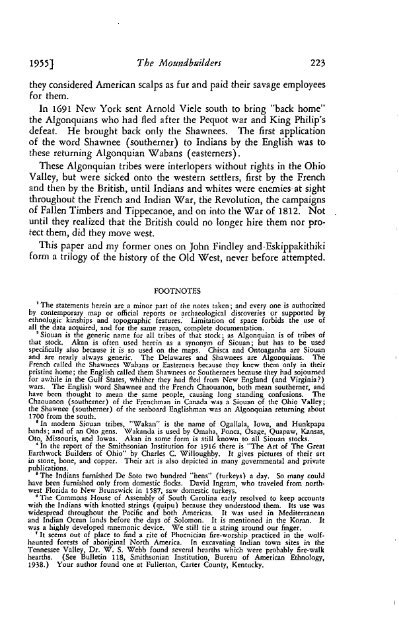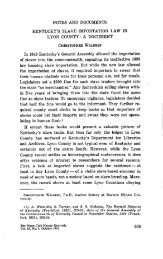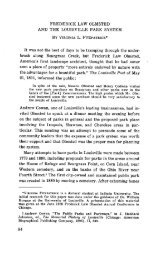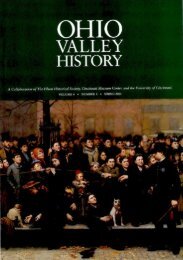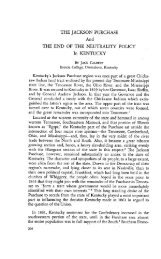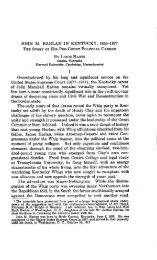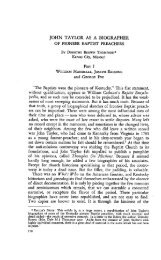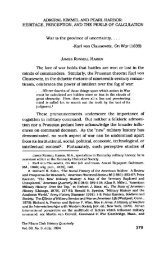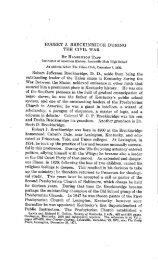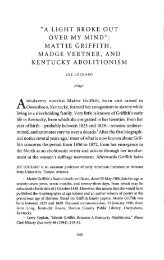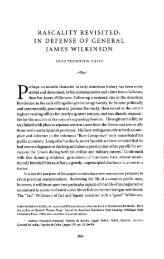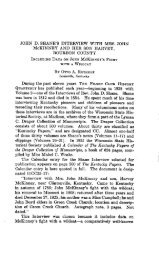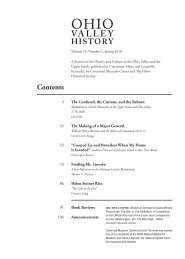the filson club history quarterly - The Filson Historical Society
the filson club history quarterly - The Filson Historical Society
the filson club history quarterly - The Filson Historical Society
Create successful ePaper yourself
Turn your PDF publications into a flip-book with our unique Google optimized e-Paper software.
1955] <strong>The</strong> Moundbuilders 223<br />
<strong>the</strong>y considered American scalps as fur and paid <strong>the</strong>ir savage employees<br />
for <strong>the</strong>m.<br />
In 1691 New York sent Arnold Viele south to bring "back home"<br />
<strong>the</strong> Algonquians who had fled after <strong>the</strong> Pequot war and King Philip's<br />
defeat. He brought back only <strong>the</strong> Shawnees. <strong>The</strong> first application<br />
of <strong>the</strong> word Shawnee (sou<strong>the</strong>rner) to Indians by <strong>the</strong> English was to<br />
<strong>the</strong>se returning Algonquian Wabans (easterners).<br />
<strong>The</strong>se Algonquian tribes were interlopers without rights in <strong>the</strong> Ohio<br />
Valley, but were sicked onto <strong>the</strong> western settlers, first by <strong>the</strong> French<br />
and <strong>the</strong>n by <strong>the</strong> British, until Indians and whites were enemies at sight<br />
throughout <strong>the</strong> French and Indian War, <strong>the</strong> Revolution, <strong>the</strong> campaigns<br />
of Fallen Timbers and Tippecanoe, and on into <strong>the</strong> War of 1812. Not<br />
until <strong>the</strong>y realized that <strong>the</strong> British could no longer hire <strong>the</strong>m nor protect<br />
<strong>the</strong>m, did <strong>the</strong>y move west.<br />
This paper and my former ones on John Findley and-Eskippakithiki<br />
forna a trilogy of <strong>the</strong> <strong>history</strong> of <strong>the</strong> Old West, never before attempted.<br />
FOOTNOTES<br />
<strong>The</strong> statements herein are a minor part of <strong>the</strong> notes taken ; and every one is authorized<br />
by contemporary map or otficial reports or archaeological discoveries or supported by<br />
ethnologic kinships and topographic features. Limitation of space forbids <strong>the</strong> use of<br />
all <strong>the</strong> data acquired, and for <strong>the</strong> same reason, complete documentation.<br />
Siouan is <strong>the</strong> generic name for all tribes of that stock; as Algonquian is of tribes of<br />
that stock. Akan is often used herein as a synonym of Siouan; but has to be used<br />
specifically also because it is so used on <strong>the</strong> maps. Chisca and Ontoaganha are Siouan<br />
and are nearly always generic. <strong>The</strong> Delawares and Shawnees are Algonquians. Tbe<br />
French called <strong>the</strong> Shawnees Wabans or Easterners because <strong>the</strong>y knew <strong>the</strong>m only in <strong>the</strong>ir<br />
pristine home; <strong>the</strong> English called <strong>the</strong>m Shawnees or Sou<strong>the</strong>rners because <strong>the</strong>y had sojourned<br />
for awhile in tile Gulf States, whi<strong>the</strong>r <strong>the</strong>y had fled from New England (and Virginia?)<br />
wars. <strong>The</strong> English word Shawnee and <strong>the</strong> French Chaouanon, both mean sou<strong>the</strong>rner, and<br />
have been thought to mean <strong>the</strong> same people causing long standing confusions. <strong>The</strong><br />
Chaouanon (sou<strong>the</strong>rner) of <strong>the</strong> Frenchman in Canada was a Siouan of <strong>the</strong> Ohio Val ey;<br />
<strong>the</strong> Shawnee (sou<strong>the</strong>rner) of <strong>the</strong> seaboard Englishman was an Algonquian returning about<br />
1700 from <strong>the</strong> south.<br />
* In modern Siouan tribes, "Wakan" is <strong>the</strong> name of Ogallala, Iowa, and Hunkpapa<br />
bands; and of an Oto gens. Wakanda is used by Omaha, Ponea, Osage, Quapaw, Kansas,<br />
Oto, Missouris, and lowas. Akan in some form is still known to all Siouan stocks.<br />
•In <strong>the</strong> report of <strong>the</strong> Smithsonian Institution for 1916 <strong>the</strong>re is "<strong>The</strong> Art of <strong>The</strong> Great<br />
Earthwork Builders of Ohio" by Charles C. Willoughby. It gives pictures of <strong>the</strong>ir art<br />
in stone, bone, and copper. <strong>The</strong>ir art is also depicted in many governmental and private<br />
publications.<br />
*<strong>The</strong> Indians furnished De Soto two hundred "hens" (turkeys) a day. So many could<br />
have been furnished only from domestic flocks. David lngram who traveled from northwest<br />
Florida to New Brunswick in 1587, saw domestic turkeys.<br />
' <strong>The</strong> Commons House of Assembly of South Carolina early resolved to keep accounts<br />
with <strong>the</strong> Indians with knotted strings (quipu) because <strong>the</strong>y understood <strong>the</strong>m. Its use was<br />
widespread throughout <strong>the</strong> Pacific and both Americas. It was used in Mediterranean<br />
and Indian Ocean lands before <strong>the</strong> days of Solomon. It is mentioned in <strong>the</strong> Koran. It<br />
was a highly developed mnemonic device. We still tie a string around our finger.<br />
v It seems out of place to find a rite of Phoenician fire-worship practiced in <strong>the</strong> wolfhaunted<br />
forests of aboriginal North America. In excavating Indian town sites in <strong>the</strong><br />
Tennessee Valley, Dr. W. S. Webb found several hearths which were probably fire-walk<br />
hearths. (See Bulletin 118, Smithsonian Institution, Bureau of American Ethnology,<br />
1938.) Your author found one at Fullerton, Carter County, Kentucky.


